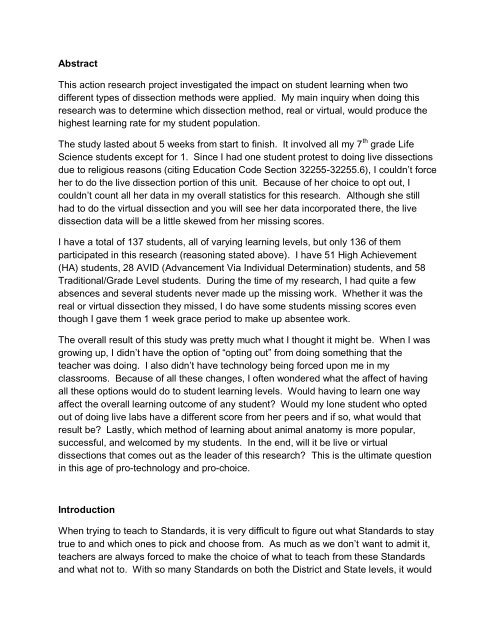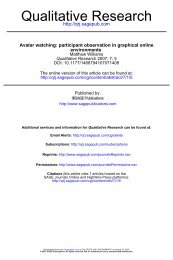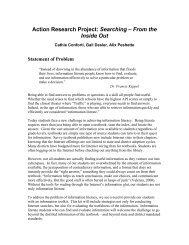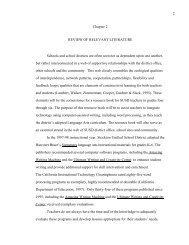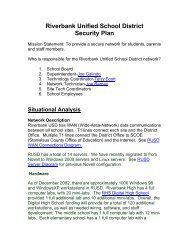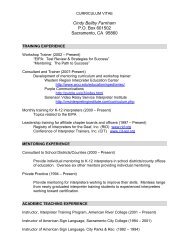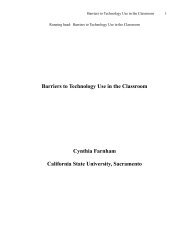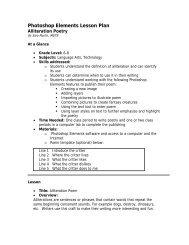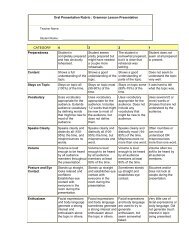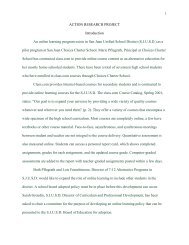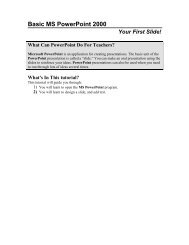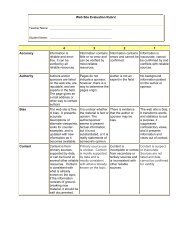Abstract This action research project investigated the impact ... - iMET
Abstract This action research project investigated the impact ... - iMET
Abstract This action research project investigated the impact ... - iMET
You also want an ePaper? Increase the reach of your titles
YUMPU automatically turns print PDFs into web optimized ePapers that Google loves.
<strong>Abstract</strong><strong>This</strong> <strong>action</strong> <strong>research</strong> <strong>project</strong> <strong>investigated</strong> <strong>the</strong> <strong>impact</strong> on student learning when twodifferent types of dissection methods were applied. My main inquiry when doing this<strong>research</strong> was to determine which dissection method, real or virtual, would produce <strong>the</strong>highest learning rate for my student population.The study lasted about 5 weeks from start to finish. It involved all my 7 th grade LifeScience students except for 1. Since I had one student protest to doing live dissectionsdue to religious reasons (citing Education Code Section 32255-32255.6), I couldn’t forceher to do <strong>the</strong> live dissection portion of this unit. Because of her choice to opt out, Icouldn’t count all her data in my overall statistics for this <strong>research</strong>. Although she stillhad to do <strong>the</strong> virtual dissection and you will see her data incorporated <strong>the</strong>re, <strong>the</strong> livedissection data will be a little skewed from her missing scores.I have a total of 137 students, all of varying learning levels, but only 136 of <strong>the</strong>mparticipated in this <strong>research</strong> (reasoning stated above). I have 51 High Achievement(HA) students, 28 AVID (Advancement Via Individual Determination) students, and 58Traditional/Grade Level students. During <strong>the</strong> time of my <strong>research</strong>, I had quite a fewabsences and several students never made up <strong>the</strong> missing work. Whe<strong>the</strong>r it was <strong>the</strong>real or virtual dissection <strong>the</strong>y missed, I do have some students missing scores eventhough I gave <strong>the</strong>m 1 week grace period to make up absentee work.The overall result of this study was pretty much what I thought it might be. When I wasgrowing up, I didn’t have <strong>the</strong> option of “opting out” from doing something that <strong>the</strong>teacher was doing. I also didn’t have technology being forced upon me in myclassrooms. Because of all <strong>the</strong>se changes, I often wondered what <strong>the</strong> affect of havingall <strong>the</strong>se options would do to student learning levels. Would having to learn one wayaffect <strong>the</strong> overall learning outcome of any student? Would my lone student who optedout of doing live labs have a different score from her peers and if so, what would thatresult be? Lastly, which method of learning about animal anatomy is more popular,successful, and welcomed by my students. In <strong>the</strong> end, will it be live or virtualdissections that comes out as <strong>the</strong> leader of this <strong>research</strong>? <strong>This</strong> is <strong>the</strong> ultimate questionin this age of pro-technology and pro-choice.IntroductionWhen trying to teach to Standards, it is very difficult to figure out what Standards to staytrue to and which ones to pick and choose from. As much as we don’t want to admit it,teachers are always forced to make <strong>the</strong> choice of what to teach from <strong>the</strong>se Standardsand what not to. With so many Standards on both <strong>the</strong> District and State levels, it would
e close to impossible to teach everything in <strong>the</strong>m, regardless of what level <strong>the</strong>y are. Inmaking <strong>the</strong> decision of which area gets what amount of time, we also have to decidewhich method of teaching would be most beneficial as well as convenient to ourstudents. We can’t possibly rely on one teaching method or way of teaching if it isn’tworking for our students. <strong>This</strong> is especially true in this age of technology convertedclassrooms. With <strong>the</strong> hype of going technical, how does one know how helpful thismove will be on <strong>the</strong> students of today if we don’t do <strong>research</strong> on it. <strong>This</strong> is whatprovoked me to conduct my study.Last year, when I first started <strong>iMET</strong>11, I was a part of <strong>the</strong> Science Textbook PilotingProgram for San Juan Unified District. During this process of picking an ideal book forour student population in our district’s geographical area, North East Sacramento, wegot first hand insight into <strong>the</strong> new Science books. It was also during this one yearprocess that I realized <strong>the</strong> textbooks of today were changing. Since we only go througha book adoption every 7-8 years, it seems inevitable that <strong>the</strong> content and format of ourtextbooks would change. Although I knew this going into this Science Book PilotingProgram, I was still taken back by <strong>the</strong> dramatic change. In every Science textbook,<strong>the</strong>re were at least 2-5 computer based dissections incorporated into <strong>the</strong>m. Not onlythis, but every chapter had a minimum of 5 different lessons that were technologybased. It seemed like every o<strong>the</strong>r page referenced something that had to do withcomputers. For an individual, such as me, who is known to be computer shy/illiterate,<strong>the</strong>se changes were a bit overwhelming to me.Our administrators are always emphasizing that we teach to <strong>the</strong> books because of <strong>the</strong>irthoroughness in covering <strong>the</strong> State Standards, but how can a non-techie teacher beexpected to do this? And if I personally feel this way, which’s to say some of mystudents wouldn’t ei<strong>the</strong>r. Will making <strong>the</strong> world more accepting to technology meansthat everyone who is in <strong>the</strong> path of this mission will benefit from it? Will teaching withmore technology or even based on technology methods help or hurt my students?What will <strong>the</strong>ir feelings/<strong>action</strong>s show when confronted with learning <strong>the</strong> old school way(hands-on) vs. <strong>the</strong> new age way (computer based)? <strong>This</strong> is what I wanted to know. Inorder to answer my inquiry, I set up a study for all my students. I was going to have<strong>the</strong>m do a few virtual dissections and <strong>the</strong>n I would compare those results to those of ahands-on live dissection. I would <strong>the</strong>n use different forms of assessments to determinewhich method was more successful.Research QuestionsWhat do you think would be an easier method of learning, hands-on (in class) or virtual(using computers)?
Have any of you had any previous experience with ei<strong>the</strong>r method in Science?What method do you think you’ll be most successful in? Why?Which do you think would be harder to do/learn from?Do you have a preference on which one you like more?Why do you think your outcome to both <strong>the</strong>se methods is what <strong>the</strong>y are?Are you surprised by <strong>the</strong> outcome of this study?How do you feel about <strong>the</strong>se learning methods now?SettingThe group members who will be included in <strong>the</strong> study are my 7 th grade Life Scienceclasses. My school is located in an urban community in Sacramento. The studentscome from a diverse population and about 20% of <strong>the</strong>m are bused in from differentareas. The majority of my students are Caucasian (75%) and <strong>the</strong>ir parents are middleupperclass people and mostly educated. The second biggest group of students isHispanics (20%) and <strong>the</strong>y come from parents who fall under <strong>the</strong> lower class withoutmuch of an education. The next group of student is Asians (10%) and <strong>the</strong>ir parents arealso middle-upper class individuals who are mostly educated. The last group ofstudents falls under “o<strong>the</strong>r” and make up 5% of <strong>the</strong> population. The level of educationof <strong>the</strong>se parents is unknown, but I assume is quite low.I have three levels of Science classes and <strong>the</strong>y are: High Achiever (HA), AVID, andTraditional. The HA class is my honors group and are taught with material that is 2grade levels higher than <strong>the</strong> Traditional group. The AVID students are taught with <strong>the</strong>same material as <strong>the</strong> HA and <strong>the</strong> Traditional class, but <strong>the</strong> pacing is slower than HA.The Traditional class is taught at grade level and <strong>the</strong> pacing is very slow with lots ofmodifications and accommodations made in this class.Description of Study<strong>This</strong> <strong>action</strong> <strong>research</strong> was completed during <strong>the</strong> Animal Kingdom Unitand took up 5 weeks time from this 12 week unit. During <strong>the</strong> first weekof <strong>the</strong> study, starting March 9 th , I sent home a survey that informed <strong>the</strong>students and parents that I would be collecting data from <strong>the</strong> dissectionportion of this unit for <strong>research</strong> purposes. It took me 3 days to collectall of <strong>the</strong> surveys and <strong>the</strong> response of <strong>the</strong>m was: I got every surveyback with 4 students not to have <strong>the</strong>ir scores disclosed in anonymously,
and 1 student that opted out of doing any animal dissections at all.Since my students have every right to protest certain teaching methodsif it goes against <strong>the</strong>ir core beliefs, I had no choice but to let here optout of doing live dissections. Since she cited Education Code Section32255-32255.6, which states an individual can’t not be forced intolearning activities that go against <strong>the</strong>ir religious/traditional beliefs, myhands were tied only in making her do <strong>the</strong> live labs. She was not ableto opt out of <strong>the</strong> virtual dissections though and this would give me greatinsight into how well she would do when missing <strong>the</strong> hands-on labexperience.During <strong>the</strong> 5 weeks of <strong>the</strong> study I had my students do a hands-on labdissection on a worm. I conducted <strong>the</strong> lab as I normally would, byteaching <strong>the</strong>m all about <strong>the</strong> anatomy of <strong>the</strong> worm first. Then I had <strong>the</strong>mwork on drawing <strong>the</strong> worm, with its parts labeled and colored. After <strong>the</strong>introduction portion of this sub-unit and before <strong>the</strong> actual dissection, Igave my students a pre-dissection survey. After all this, <strong>the</strong>y had todissect <strong>the</strong> worm using all <strong>the</strong>se resources. From <strong>the</strong> point ofintroduction of <strong>the</strong> Worm sub-unit, it took me 7 days to get completelythrough <strong>the</strong> live dissections, survey <strong>the</strong>m post dissection, and give<strong>the</strong>m an assessment on <strong>the</strong> Worm Lab.I <strong>the</strong>n signed up for some computer lab time for all my classes. <strong>This</strong>was <strong>the</strong> most time consuming part of this study. Since we have ashared computer lab, <strong>the</strong>re were days when I could get <strong>the</strong> lab for 3classes and not 2 that same day. Then I would get 4 periods in <strong>the</strong> laband not 1 class. Ano<strong>the</strong>r frustration with using a communal computerroom, was when I got <strong>the</strong>re, some students were already using <strong>the</strong>m. Ittook me a good 2 weeks to get enough time for my students to do 2different virtual dissections. After this process, I gave all my studentspre-virtual dissections survey questions. I <strong>the</strong>n took <strong>the</strong>m into <strong>the</strong>computer lab on <strong>the</strong> days I was able to sign up for it. We went through<strong>the</strong> two virtual dissections, took <strong>the</strong> post dissections survey, and took aquiz on it. During <strong>the</strong>se 5 weeks of studying <strong>the</strong> <strong>impact</strong> of dissectionson students, I was also keeping a day-by-day journal of what washappening as it did.Limitations of <strong>the</strong> StudyAs with all studies/experiments, <strong>the</strong>re are always constants that will be beyond <strong>the</strong>experimenters/<strong>research</strong>ers control. Since <strong>the</strong> in-class dissection labs are already builtinto my curriculum, I didn’t have many problems in this area except for studentabsences. The main area I felt might give me problems was <strong>the</strong> online dissections.Since I don’t normally use virtual labs in my curriculum and I don’t have full access to a
computer lab anytime I need it, <strong>the</strong>re were many factors I had to overcome even before<strong>the</strong> study began. Ano<strong>the</strong>r limitation was that my students didn’t have <strong>the</strong> same level ofexposure to computers use. I know this because some of my students informed me at<strong>the</strong> beginning of <strong>the</strong> year that <strong>the</strong>y didn’t have any email addresses due to lack ofhaving a computer at home. These are some of <strong>the</strong> areas of limitation for my study.TimelineWeek 1 – March 9 th to 13 th 2009I distributed <strong>the</strong> dissection study informative handout to student/parent and collected<strong>the</strong>m from all my 139 students. I had 138 opt in and 1 opt out of <strong>the</strong> live animaldissections. I had 4 individuals request for <strong>the</strong>ir data not to be disclosed. I also handedout <strong>the</strong> pre-dissection survey questions for <strong>the</strong> animal dissections and collected <strong>the</strong>mthis first week. The last 2 days of this week, I handed out <strong>the</strong> introduction worksheetsfor <strong>the</strong> Worm Unit. <strong>This</strong> gave <strong>the</strong> students <strong>the</strong> weekend to get familiar with <strong>the</strong> anatomyof our first dissection animal.Week 2 – March 16 th to 20 th 2009We spent this week learning about <strong>the</strong> anatomy of worms. We spent time onsegmented worms, round worms, and flat worms. We ended <strong>the</strong> week concentrating on<strong>the</strong> segmented worm.Week 3 – March 23 rd to 27 th 2009I had <strong>the</strong> students work on <strong>the</strong> Worm Dissection this week. The week ended with aWorm review (Thursday) and a quiz on Friday. I also spent time signing up forcomputer lab time this week. I was able to get time to work in <strong>the</strong> lab on Monday, partof Tuesday, and 1 period on Wednesday.Week 4 – March 30 to April 3 rd 2009I gave <strong>the</strong> pre-dissection survey for <strong>the</strong> virtual labs on Monday. We <strong>the</strong>n headed overto <strong>the</strong> computer lab, but discovered that ano<strong>the</strong>r class signed up for <strong>the</strong> lab AFTER I didfor 6 th period. Since it was <strong>the</strong> Computer Exploration class that conflicted with my signup time, I had to give up <strong>the</strong> lab time slot I signed up for. <strong>This</strong> was frustrating. Weended up spending periods 1-5 in lab on Monday, 1-6 in lab on Tuesday, and period 6on Wednesday.Links to virtual dissections:
Virtual Frog Dissection:http://mariemarie0000.free.fr/fichiers/images/frog.swfVirtual Eye Dissection:http://www.eschoolonline.com/company/examples/eye/eyedissect.htmlWeek 5 – April 6 th to April 10 th 2009I handed out <strong>the</strong> post dissection virtual lab surveys on Monday and scheduled a quiz forThursday on <strong>the</strong> virtual labs. We spent part of Wednesday studying <strong>the</strong> material. <strong>This</strong>week also gave me time to get all my surveys in as well as giving time to my absenteestudents to make up missing in class and virtual lab work.Presentation of DataResults from: Letter Informing Students/Parents of Intent toCollect and Share DataTraditional/Grade Level ClassesStudent population 58Student that approve 58Students that disapprove 0Student’s non-approval for data sharing 2
6050403020100TraditionalLevelStudentsApproveDisapproveNo Disclosure ofdataHigh Achievement (HA) Level ClassesStudent population 51Student that approve 50Students that disapprove 1Student’s non-approval for data sharing 2
50454035302520151050HA LevelStudentsApproveDisapproveNo Disclosure ofDataAVID Level ClassesStudent population 28Student that approve 28Students that disapprove 0Student’s non-approval for data sharing 0
302520151050AVIDLevelStudentsApproveDisapproveNo Disclosure ofDataPre-Dissection Survey ResultsReal DissectionsPeriods 1-6 (No data provided for 3rd period=prep)1. Do you have previous dissection experience? Yes2. Do you have previous dissection experience? No3. You are comfortable with dissections? Yes4. You are comfortable with dissections? NoPeriod-1 Period-2 Period-4 Period-5 Period-6Prev Dissection Ex 6 5 4 13 23No Prior Experience 27 26 17 14 2High Comfort w/ Di 10 11 8 14 6Low Comfort w/ Di 23 20 13 13 19
Period-1Period-2Period-4Period-5Period-6Post-Dissection Survey ResultsReal DissectionsPeriods 1-6 (No data provided for 3rd period=prep)1. How do you feel about dissections now? Good2. How do you feel about dissections now? Bad3. Was this dissection easy? Yes4. Was this dissection easy? NoPeriod-1 Period-2 Period-4 Period-5 Period-6Feelings-Good 6 4 11 15 5Feelings-Bad 27 26 10 8 20Dissections Easy 18 6 17 5 6Dissections Hard 15 24 4 18 19
Period-1Period-2Period-4Period-5Period-6Animal Dissection (Hands-On) AssessmentQuiz on Worm Anatomy(No 3 rd period data due to prep)Period-1 Period-2 Period-4 Period-5 Period-680% or higher (A or B) 23 24 17 18 1065% to 79% ( C ) 7 4 2 6 4Below 64% (Not passing) 3 2 2 4 11
3025201510580% or higher(Aor B)65% to 79% ( C )Below 64% (Notpassing)0Per-1 Peri-2 Per-4 Per-5 Per-6Pre-Dissection Survey ResultsVirtual DissectionsPeriods 1-6 (No data provided for 3rd period=prep)1. Do you have previous virtual dissection experience? Yes2. Do you have previous virtual dissection experience? No3. You are comfortable with virtual dissections? Yes4. You are comfortable with virtual dissections? No
Period-1 Period-2 Period-4 Period-5 Period-6Feelings-Good 25 19 16 13 18Feelings-Bad 8 11 5 15 17Dissections Easy 26 25 17 18 20Dissections Hard 7 5 4 10 5Problems-Yes 30 5 19 20 23Problems-No 3 25 2 8 2Period-1Period-2Period-4Period-5Period-6Animal Dissection (Virtual) AssessmentQuiz on Virtual Frog and Eye(No 3 rd period data due to prep)
Period-1 Period-2 Period-4 Period-5 Period-680% or higher(A or B) 10 16 10 8 565% to 79% ( C ) 12 13 8 10 5Below 64% (Not passing) 11 11 3 10 15181614121086420Per-1 Per-2 Per-4 Per-5 Per-680% or higher(A or B)65% to 79% ( C )Below 64% (Not passing)ConclusionIn this <strong>action</strong> <strong>research</strong>, I sought to discover <strong>the</strong> <strong>impact</strong> of different forms of dissectionson my student’s overall assessment scores. Prior to <strong>the</strong> study, my hypo<strong>the</strong>sis was thatmost students wouldn’t do as well on virtual dissections as <strong>the</strong>y would in realdissections. I believe <strong>the</strong> hands-on version of learning about animal anatomy helpscontribute to <strong>the</strong> overall learning experience you would get from doing anylab/experiment. Having <strong>the</strong> luxury of feeling, smelling, seeing, and sometimes tasting<strong>the</strong> lab supplies helps to engrain <strong>the</strong> experience inside your brain. <strong>This</strong> is what I thinkmost students gravitate towards.
If you take a look at <strong>the</strong> graph of <strong>the</strong> pre-dissection survey for both methods ofdissections, you will notice that <strong>the</strong> students seemed to struggle more on <strong>the</strong> real labs incomparison to <strong>the</strong> virtual ones. Unfortunately, <strong>the</strong>re wasn’t a correlation to assessmentscores and ease of use for <strong>the</strong> two methods. The assessment data chart and graphshow that <strong>the</strong> scores are lower on <strong>the</strong> virtual labs even though <strong>the</strong> students preferred touse this method and liked it a lot more. I thought this survey question of which methodwas preferred and easier was quite interesting because <strong>the</strong> students said <strong>the</strong> computerone was. At <strong>the</strong> same time, those who were absent and making up this assignmentthought this was <strong>the</strong> most difficult method of doing dissections. Also, this was <strong>the</strong>method that caused problems for <strong>the</strong> majority of <strong>the</strong> students. They said <strong>the</strong> computerkept skipping to different pages right in <strong>the</strong> middle of <strong>the</strong> virtual dissection.It’s quite interesting that <strong>the</strong> students didn’t prefer <strong>the</strong> one method that <strong>the</strong>y seemed tolearn more from. According to <strong>the</strong> quiz scores, <strong>the</strong> live labs had higher assessmentresults and lasting impressions. Every day <strong>the</strong> students came into <strong>the</strong> in classdissection labs and complained about <strong>the</strong> tediousness and smell of <strong>the</strong> lab. But when<strong>the</strong>y were tested on <strong>the</strong> anatomy of <strong>the</strong> animals, <strong>the</strong> one <strong>the</strong>y enjoyed <strong>the</strong> least, left <strong>the</strong>strongest impression in <strong>the</strong>ir brains. The study’s data shows that real dissections helpstudents to retain <strong>the</strong> knowledge/information <strong>the</strong>y learned at a higher rate than <strong>the</strong>virtual one.


